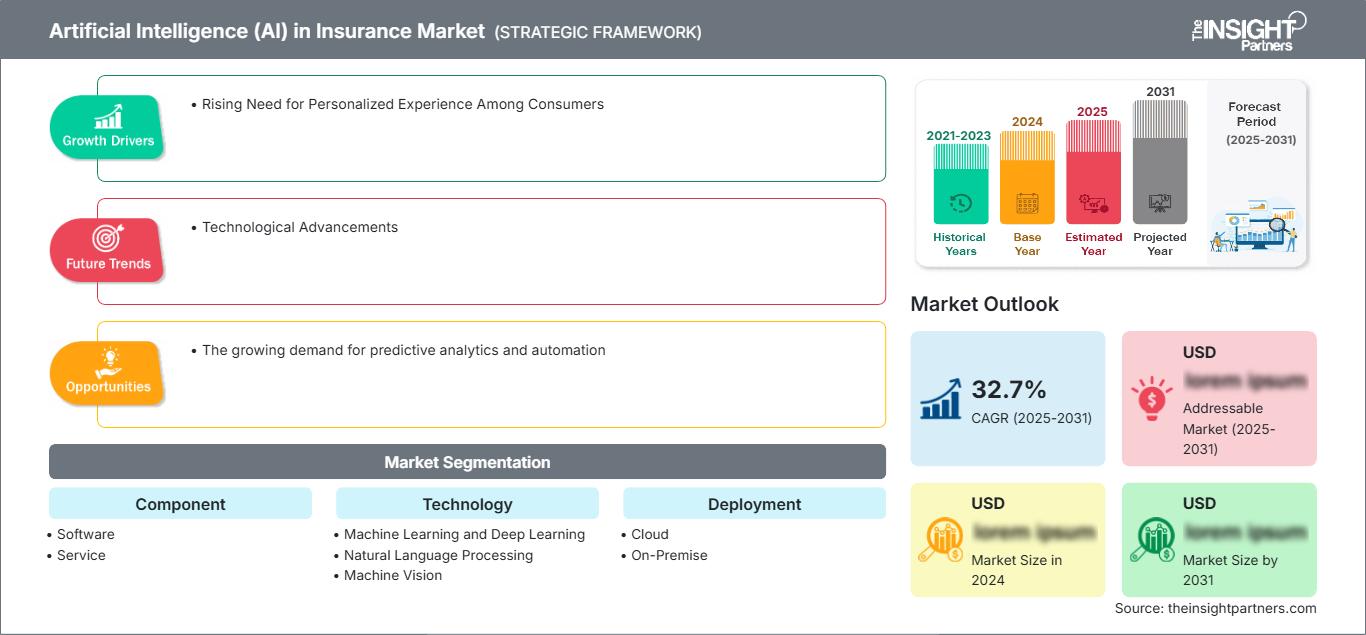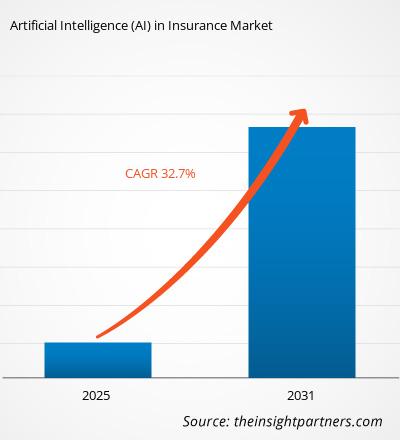보험 시장에서 인공지능(AI)은 2023~2031년 동안 32.7%의 CAGR을 기록할 것으로 예상됩니다. 예측 분석 및 자동화에 대한 수요 증가는 시장의 주요 트렌드로 남을 것으로 예상됩니다.
보험 시장 분석 분야의 인공지능(AI)
- AI 보험 부문은 보험 산업을 지원하고 방대한 양의 데이터를 최적의 수준으로 활용합니다.
- 보험사는 개인 맞춤형 보험 상품을 설계하고, 체계적인 인수 프로세스를 구축하며, 전 세계 고객에게 더욱 정확한 견적을 제공합니다.
- AI 기술을 통합하면 정확한 예측이 더욱 가능해지고, 고객 상호 작용을 관리하며, 개인 맞춤형 서비스를 확장할 수 있습니다.
보험 시장 개요 분야의 인공지능(AI)
- AI 기술은 보험 산업의 변화를 수용하여 위험을 관리하는 데 있어 다양한 잠재적 이점을 제공할 수 있습니다.
- 보험 회사는 AI 기술을 통합하여 정확한 견적을 산출하고, 고객 상호 작용을 관리하며, 전례 없는 정확성과 속도로 개인 맞춤형 서비스와 제품군을 확장하고 있습니다.
- 보험 부문에서 보증인은 AI를 사용하여 고객 서비스를 개선하고, 효율성을 높이고, 사기를 방지합니다. 효과적으로.
- AI 기술을 사용하면 보험사가 개발된 데이터 세트를 활용하여 고객 지원 기계화부터 위험 모델링 및 예측 개선까지 프로세스를 복구할 수 있습니다.
요구 사항에 맞게 이 보고서를 사용자 정의하십시오.
이 보고서의 일부, 국가 수준 분석, Excel 데이터 팩을 포함하여 모든 보고서에 대한 사용자 정의를 무료로 받을 수 있을 뿐만 아니라 스타트업 및 대학을 위한 훌륭한 제안 및 할인을 이용할 수 있습니다
보험 시장의 인공지능(AI): 전략적 통찰력

-
이 보고서의 주요 주요 시장 동향을 확인하세요.이 무료 샘플에는 시장 동향부터 추정 및 예측에 이르기까지 데이터 분석이 포함됩니다.
보험 시장에서의 인공지능(AI)의 성장 동력과 기회
시장을 선호하는 소비자들 사이에서 개인화된 경험에 대한 요구 증가
- 소비자들은 개인화된 경험을 기대하며, 이는 시장 참여자들이 보험 프로세스를 자동화하기 위해 AI 기술을 도입하도록 장려합니다.
- AI 기술은 보험 회사가 고객 데이터와 행동을 분석하는 데 도움을 줍니다. AI 알고리즘은 고객을 구분하고, 선호도와 필요 사항을 파악하며, 마케팅 메시지와 제품 추천을 맞춤화할 수 있습니다. 이는 시장 참여자의 교차 판매 및 상향 판매 기회를 늘려 고객 참여와 충성도를 높입니다.
- 챗봇 및 가상 비서와 같은 AI 기반 솔루션을 통해 보험사는 신속하고 개인화된 지원에 대한 고객 수요를 충족할 수 있으며, 이로 인해 수요가 증가하여 시장을 주도하고 있습니다.
기술 발전
- 머신 러닝, 자연어 처리, 컴퓨터 비전과 같은 첨단 기술은 보험사에서 고객 행동을 추적하고 실시간으로 데이터를 유지하기 위해 매우 요구됩니다.
- AI와 머신 러닝의 급격한 성장은 데이터에서 가치를 추출할 수 있는 새로운 기회를 제공했습니다.
- 또한 대규모 언어 모델링(LLM)은 문서에 포함된 데이터를 제공하는 인공 지능의 한 분야입니다.
- 보험사는 LLM을 사용하여 청구 프로세스를 가속화하고 사기 청구를 더욱 정확하게 감지합니다.
- 또한 생성 AI의 발전은 수집된 데이터, 도구 및 기능을 제공하여 보험을 위한 데이터 처리 및 관리 솔루션을 제공합니다. 회사.
보험 시장 보고서 세분화 분석: 인공지능(AI)
보험 시장 분석에서 인공지능(AI) 활용에 기여한 주요 분야는 제공, 배포, 기업 규모, 최종 사용자입니다.
- 구성 요소를 기준으로 보험 시장의 인공지능(AI)은 소프트웨어와 서비스로 구분됩니다. 소프트웨어 부문은 2023년에 더 큰 시장 점유율을 차지했습니다.
- 기술별로 시장은 머신러닝 및 딥러닝, 자연어 처리(NLP), 머신 비전, 로봇 자동화로 구분됩니다. 머신러닝 및 딥러닝 부문은 예측 기간 동안 상당한 속도로 성장할 것으로 예상됩니다.
- 배포 측면에서 보험 시장의 인공지능(AI)은 클라우드와 온프레미스로 구분됩니다. 클라우드 부문은 2023년에 더 큰 시장 점유율을 차지했습니다.
- 애플리케이션별로 시장은 클레임 관리, 위험 관리, 규정 준수, 챗봇 등으로 구분됩니다. 챗봇 부문은 예측 기간 동안 성장할 것으로 예상됩니다.
- 최종 사용자를 기준으로 시장은 생명 보험, 건강 보험, 소유권 보험, 자동차 보험 등으로 구분됩니다. 생명 보험 부문은 예측 기간 동안 상당한 속도로 성장할 것으로 예상됩니다.
지역별 보험 시장 점유율 분석: 인공지능(AI)
보험 시장 보고서에서 인공지능(AI)의 지리적 범위는 주로 북미, 아시아 태평양, 유럽, 중동 및 아프리카, 중남미의 5개 지역으로 나뉩니다.
- 기술 발전과 주요 시장 참여자들의 존재로 인해 아시아 태평양 시장은 예측 기간 동안 확장될 것으로 예상됩니다.
- IBM Corp, Microsoft Corp, OpenText Corporation 등은 고객의 역동적인 요구를 충족하기 위해 포트폴리오를 개발, 업그레이드 및 개선하는 데 주력하고 있으며, 이러한 흐름이 시장을 주도하고 있습니다.
보험 시장 인공지능(AI)
보험 시장의 인공지능(AI)
The Insight Partners의 분석가들은 예측 기간 동안 보험 인공지능(AI) 시장에 영향을 미치는 지역별 동향과 요인을 면밀히 분석했습니다. 이 섹션에서는 북미, 유럽, 아시아 태평양, 중동 및 아프리카, 중남미 지역의 보험 인공지능(AI) 시장 부문 및 지역에 대해서도 다룹니다.
보험 시장 보고서의 인공지능(AI) 범위
| 보고서 속성 | 세부 |
|---|---|
| 시장 규모 2024 | US$ XX million |
| 시장규모별 2031 | US$ XX Million |
| 글로벌 CAGR (2025 - 2031) | 32.7% |
| 이전 데이터 | 2021-2023 |
| 예측 기간 | 2025-2031 |
| 다루는 세그먼트 |
By 구성 요소
|
| 포함된 지역 및 국가 |
북미
|
| 시장 선도 기업 및 주요 회사 프로필 |
|
보험 시장 참여자 밀도에서의 인공지능(AI): 비즈니스 역학에 미치는 영향 이해
보험 시장에서 인공지능(AI)은 소비자 선호도 변화, 기술 발전, 그리고 상품 혜택에 대한 인식 제고 등의 요인으로 인해 최종 사용자 수요가 증가함에 따라 빠르게 성장하고 있습니다. 수요가 증가함에 따라 기업들은 상품 및 서비스를 확장하고, 소비자 니즈를 충족하기 위한 혁신을 추진하며, 새로운 트렌드를 적극 활용하고 있으며, 이는 시장 성장을 더욱 가속화하고 있습니다.

- 을 얻으세요 보험 시장의 인공지능(AI) 주요 주요 플레이어 개요
보험 시장의 인공지능(AI) 뉴스 및 최근 동향
보험 시장의 인공지능(AI)은 1차 및 2차 조사 후 주요 기업 간행물, 협회 데이터, 데이터베이스 등 정성적 및 정량적 데이터를 수집하여 평가합니다. 보험 시장에서 인공지능(AI)이 적용된 몇 가지 사례는 다음과 같습니다.
- Swiss Re는 생명보험 및 건강 보험 인수 매뉴얼 'Life Guide'의 증강 버전을 출시했습니다. 이 새로운 버전에는 Swiss Re가 개발한 생성 AI 기반 인수 지원 도구인 Swiss Re Life Guide Scout가 탑재되어 있으며, Microsoft Azure OpenAI Service를 통합합니다. 생명보험 및 건강 보험 인수는 보험 신청자의 위험을 평가하기 위해 정확하고 최신 정보가 필요한 복잡한 과정입니다. Swiss Re Life Guide Scout는 인수자가 자연어로 질문하면 엄선된 전문 지식을 바탕으로 신속한 답변을 생성하여 인수의 효율성과 품질을 높이는 것을 목표로 합니다. (출처: Swiss Re, 회사 웹사이트, 2024년 5월)
보험 시장 보고서의 인공지능(AI) 적용 범위 및 성과물
“보험 시장 규모 및 예측(2021~2031년)” 보고서는 다음 영역을 포괄하는 시장에 대한 자세한 분석을 제공합니다.
- 범위에 포함된 모든 주요 시장 부문에 대한 글로벌, 지역 및 국가 수준의 보험 시장 규모 및 예측
- 보험 시장 동향 및 동인, 제약 및 주요 기회와 같은 시장 역학
- 자세한 PEST/포터의 5가지 힘 및 SWOT 분석
- 주요 시장 동향, 글로벌 및 지역 프레임워크, 주요 업체, 규정 및 최근 시장 개발을 포괄하는 보험 시장 분석
- 시장 집중도, 히트맵 분석, 주요 업체 및 보험 시장에서 인공 지능(AI)의 최근 개발을 포괄하는 산업 환경 및 경쟁 분석
- 자세한 회사 프로필
- 과거 분석(2년), 기준 연도, CAGR을 포함한 예측(7년)
- PEST 및 SWOT 분석
- 시장 규모 가치/거래량 - 글로벌, 지역, 국가
- 산업 및 경쟁 환경
- Excel 데이터세트
최근 보고서
사용 후기
구매 이유
- 정보에 기반한 의사 결정
- 시장 역학 이해
- 경쟁 분석
- 고객 인사이트
- 시장 예측
- 위험 완화
- 전략 기획
- 투자 타당성 분석
- 신흥 시장 파악
- 마케팅 전략 강화
- 운영 효율성 향상
- 규제 동향에 발맞춰 대응






















 무료 샘플 받기 - 보험 시장의 인공지능(AI)
무료 샘플 받기 - 보험 시장의 인공지능(AI)